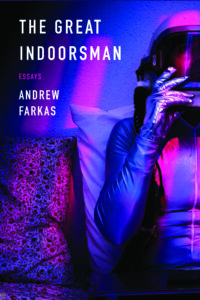
[University of Nebraska Press; 2022]
Growing up in northwestern Ohio during the last two decades of the twentieth century, I spent a lot of time inside highly specific types of rooms, some very large and some very small, that no longer exist, if not entirely, then for the most part. An inexhaustive list includes the movie rental shop, the video game arcade, the early indoor mall, the family motel, the music store, the rave warehouse, and the telephone booth. Each space came with its own character and its own set of rules; in no other kind of room, for instance, did thirteen- and fourteen-year-olds find themselves more in charge than the arcade. The mall was for lovers who were too young to drive. In every Blockbuster or Video Connection or Major Video, you grasped your duty to respect the privacy of the strangers who were also perusing the shelves. You never believed for an instant that the phone booth and its communications device were not made for whatever physical abuse you were ready to dish out. These kinds of spaces proved to be the crucibles of what passed for culture in those years. We knew and relished it, as any casual viewing of films filed under the “independent” genre of the 1990s will demonstrate. For those of us who were children and teens, the indoor culture of the dying century was wonderful, not least because we were so young and because we imagined things were getting better.
I found myself reflecting on these years when most of us had yet to grasp the direction, rate, and degree of American decline as I read Andrew Farkas’s essay collection The Great Indoorsman. Ironic, joking, thoughtful, nostalgic, and moving, these lyric essays, reflections, lighthearted arguments, and odes meditate playfully on the peculiar human environments we discover indoors.
Framed by the conceit of its author as a kind of explorer, The Great Indoorsman opens with an exploration of the aesthetic pleasures of cultural compartmentalization. Farkas clearly sets this theme by calling the reader’s attention to a range of modern American spaces: a dive bar, the casino, Chicago’s Signature Lounge, a massive furniture store, a Lyft cab, and a wretched apartment he once inhabited in Wellsburg, West Virginia — a firetrap so barely livable that Farkas had to go to the deli down the street to use the bathroom. Farkas writes thoughtfully about each of these interiors, but his thoughts on this last add a level of seriousness to the work’s overall tone. He reminds us that to live in the United States is to encounter as many abominations as luxuries, and to encounter them in unpredictable quantities and rates: at the wedding reception, while the nuptials kiss, we deduce that we are eating the flesh of animals raised in conditions too cruel and disgusting for horror novels. The subway car proves to be simultaneously a wonder of modern transit and a temporary residence for a stranger devastated by psychological disorder and social neglect. Thriving in such environments may require an unconventional heroism. This is how Farkas says he came to see the matter when he was young:
I’d master resignation, not in a broken and defeated way, not in a fatalistic way, but more in the Falstaffian way of being gloriously resigned to the pleasures and experiences which suit me, those being the modulated wantonness and controlled chaos of the In-of-Doors.
Farkas’s interior hero makes good company. He excavates many indoor spaces, never failing to discover qualities and patterns of note, telling stories and cracking jokes, and generally saying interesting things. He visits the waiting room, the pool hall, the movie rental shop, a high school slated for demolition, the laundromat, the comic book shop, the coffee shop, the drug store stockroom, the classroom, the mom-and-pop burger joint, the early American shopping mall, and the bowling alley. As readers acquainted with the traditional descriptive-analytic concern of the essay will expect, his eye falls on the commonplace qualities that give these spaces universal character, as demonstrated in this description of the second-run theater:
big old marquee, [theater name] coolly burning in blue neon script, the sign hinged at a point that pulses red bottom to top, luring your eyes ever upward where yellow and white swooshes glow, the whole shebang either a bright, blaring beacon beckoning you to the fantasy world inside, or a self-conscious nostalgia machine that seduces you, convincing you to go ahead, indulge in that hankering you have for movies.
Yet there’s more to this book than the poetry of cultural examination. Farkas tweaks the familiar formula in a few ways, with results that range from the effectively textural to the thematically surprising and conceptually productive. For instance, he’s wont to shift into a lyrical mode in the shorter essays, employing rhetorical devices like apostrophe — “Why do you hate the waiting room?” one particularly inquisitive Farkas-persona asks; narrative frameworks — “. . . I have gone, have studied, have seen (and still see) the world like few others ever have, and yet I am not mad. I, contrary to the beliefs of my detractors, am gloriously sane,” declares a Lovecraftian Farkas who boasts of adventures in bookshops; and lexically rich lists — including a rundown of all the burger joints in Kent, Ohio (there are more than you might imagine) — to give the prose a comic shot in the arm. In longer pieces, he explicitly relates literal interiors to the textual ones, as in the essay where he braids a story of a college friendship with a story of using an episode of Seinfeld to teach college students Samuel Beckett. The move to treat the essay as an indoor space in its own right is a productive one, as it moves the whole collection into a realm of personal archeology. It’s not culture Farkas is studying so much as the many interiors of the self.
Despite this turn, the book resists the temptation to drift fully into memoir, and the stories and characters that do make it onto the page usually do so fleetingly. These glimpses of personal narrative lend the prose a satisfying alterity that makes each essay a little work of art while reinforcing the author’s “Falstaffian” ethos. In time, this seriocomic otherness reveals itself to be a form of personal discipline, a cunning reinvention of classic Midwestern stoicism. At its best moments, this sensibility allows Farkas to have his painstakingly crafted cake and eat it, too, conveying the idea that the mind is the fundamental “In-of-Doors,” as the author puts it, and leaving affectionate traces of other people — friends, classmates, potential lovers, and especially his father. There are also all the places Farkas writes about with careful attention to detail, treating even the dowdiest laundromat as if it were a site of cultural significance. And that’s the point in the end. These places don’t necessarily mean anything, at least not in some high-minded theoretical sense, but they matter in the most visceral, vivid, and enduring sense.
The world, we know, is a terrible, terrifying, disappointing place. It’s also a lot of fun. Further, it’s the only world we have, the one where we live out our days and nights. It’s the one where we exist even as we consider how best to proceed. We are part of it, which is a way of saying that it happens to us far more than we, at least as individuals, could be said to happen to it. Yet it is not enough to live passively. As Farkas states the problem, vis-à-vis Seinfeld and Waiting for Godot:
although it approaches the topic, Waiting for Godot isn’t about nothing. It’s about the fact that people are constantly waiting for someone to deliver them from their situations, when they should actually do something themselves.
This statement is not without a politics. But it is less a political statement than an aesthetic, existential one. This is a book concerned with how to live with the atmospheres we neither create nor control and must nonetheless inhabit; it instructs by example rather than with clumsy explanations or advice. It feels very Midwestern to me, and, because I spent half my life in that part of the country, it also feels very familiar. Closing the book, I was reminded of the exhortation of another Falstaffian American writer, Thomas Pynchon, in his novel V: “Love with your mouth shut, help without breaking your ass or publicizing it: keep cool, but care.” Let’s not make a big deal of it, Farkas’s book quietly tells us, but all those places you went existed, and so did you, and so did everybody who was there, and everything, all of it, mattered.
Hugh Sheehy is the author of two books of short stories, Design Flaw, forthcoming from Acre Books, and The Invisibles, published by University of Georgia Press. He lives in Beacon, NY and teaches at Ramapo College of New Jersey.
This post may contain affiliate links.







